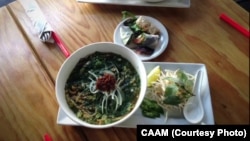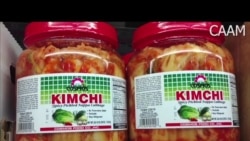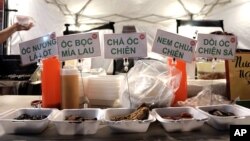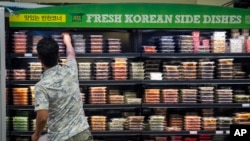For much of the 20th century, for many Americans, Asian food meant chop suey or chow mein or other Chinese-style dishes. No longer - Americans may now choose from restaurants featuring Japanese, Thai, Korean, Indian, Burmese and other Asian cuisines.
In her documentary “Off the Menu,” Korean-American filmmaker Grace Lee traveled off the beaten path to explore how food reflects an evolving Asian Pacific America.
"How food tells the story of our communities and that’s what we were going for with the film," she explains.
Lee has seen a change in Americans' awareness of Asian cuisine over the past few decades, since she grew up in Columbia, Missouri, one of a very few Asian families.
"We sort of kept our kimchi to ourselves in our basement refrigerator. And we never exposed it to anybody," she said. "But now kimchi is so popular. As we say in the film, [chefs are] putting it on quesadillas, on burgers, it’s like a condiment like sriracha."
Tofu in Texas, curry in Wisconsin
Tofu is another recent popular addition to the American menu, showing up in unexpected places - like Texas, where Gary Chiu, the son of Taiwanese immigrants, runs Banyan Foods, the oldest tofu factory in the state.
"In 2000, we started doing tofu eggrolls," he told Lee, "In 2005, we started doing tofu tamales, which is an Asian Tex-Mex fusion."
Lee says Chiu’s family business is an example of how Asian Americans have adapted to other cultures.
"It may not be authentically Chinese or authentically Mexican, because of the ingredient of tofu, but it does reflect their existence as Asian Americans in Texas where there is a Tex-Mex culture, Tex-Mex food, and actually in the factory most of the employees are Latino. So they’re also sort of fusing together their cultures," she said.
At the Sikh Temple in Oak Creek, Wisconsin, Lee visited the scene of the 2012 shooting, where a gunman killed six people during a racially motivated rampage. When the tragedy occurred, the Sikh community was preparing for langer, a communal meal open to everyone.
‘Spiritual’ element
Today, temple members continue to make and share the free communal meal. They say it’s helped to heal the community and also feed it spiritually.
"We believe that the reason why food is important is because you can’t pray, you can’t be in tune in with God, unless your belly is full," one temple member says in the film.
Another explains, "We are not scared of anybody coming to gurdwara [temple]. So still our doors are open, our hearts are open, our langer is open for them. And we feel honored when they come to us and join with us in our langer."
“Off the Menu” ends its journey in Hawaii, where most of the state’s food is now imported. But it wasn’t always like that. These days, some Native Hawaiians continue to gather food just like their ancestors. Hi’ilei Kawelo learned how to do it from her father, Gabby Kawelo. She says being able to carry on their cultural traditions is an important part of her identity, and preserving their island way of life means a lot to her family.
"When we do family luau, we still gather everything ourselves," she said. "The whole point of a luau is that a family comes together and you’re pulling the resources that’s either grown or harvested. And so when you eat it, you’re eating the essence of all the skills passed down from generation to generation. And you take that bite of that food and you’re eating that. Food has mana [spiritual power].… You can taste the love and the history behind that food."
Food as connection
"Off the Menu" captures the role food plays in peoples’ lives, connecting family, culture and community. Broadcast nationally on PBS, the film is now available on DVD. It was also shown internationally, as part of the American Film Showcase.
Co-produced by the Center for Asian American Media and the San Francisco public TV station KQED, with funding from the Corporation for Public Broadcasting, filmmaker Grace Lee hopes “Off the Menu” gives people a better understanding of the evolving experience of Asian Pacific Americans.










